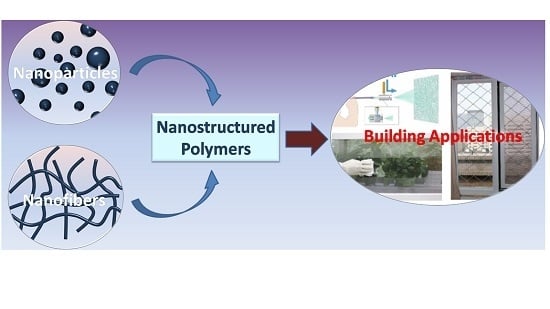Synthesis, Morphologies and Building Applications of Nanostructured Polymers
Abstract
:1. Introduction
1.1. Polymer Nanoparticles (PNPs)
1.2. Polymer Nanofibers (PNFs)
2. Nanosynthesis of Representative Polymers Used in Construction
2.1. Synthesis of Nanostructured Polyurethane (NS-PU)
2.2. Synthesis of Nanostructured Polystyrene (NS-PS)
2.3. Synthesis of Nanostructured Polyacrylonitrile (NS-PAN)
2.4. Synthesis of Nanostructured Polyvinyl Chloride (NS-PVC)
3. Building Applications of Polymers Used in Construction Industry
3.1. Air Filtration
3.2. Thermal Energy Storage
3.3. Sound Absorption
3.4. Other Applications
3.4.1. Anti-corrosion Coating
3.4.2. Metal Coating
3.4.3. Reinforced Adhesive
3.4.4. Flame Retardant
4. Outlook and Conclusions
Acknowledgments
Author Contributions
Conflicts of Interest
References
- Needham, R.B.; Doe, P.H. Polymer flooding review. J. Pet. Technol. 1987, 39, 1503–1507. [Google Scholar] [CrossRef]
- Cheung, H.Y.; Lau, K.T.; Lu, T.P.; Hui, D. A critical review on polymer-based bio-engineered materials for scaffold development. Compos. Part B 2007, 38, 291–300. [Google Scholar] [CrossRef]
- Shrive, N.G. The use of fibre reinforced polymers to improve seismic resistance of masonry. Constr. Build. Mater. 2006, 20, 269–277. [Google Scholar] [CrossRef]
- Halliwell, S.M. Polymers in Building and Construction; Rapra Review Report; Rapra Technology Ltd.: Shropshire, UK, 2002; Volume 13, ISSN 0889-3144. [Google Scholar]
- Herrmann, A.S.; Nickel, J.; Riedel, U. Construction materials based upon biologically renewable resources-from components to finished parts. Polym. Degrad. Stab. 1998, 59, 251–261. [Google Scholar] [CrossRef]
- Feldman, D. Polymer nanocomposites in building, construction. J. Macromol. Sci. Part A Pure Appl. Chem. 2014, 51, 203–209. [Google Scholar] [CrossRef]
- Rana1, A.K.; Rana, S.B.; Kumari, A.; Kiran, V. Significance of nanotechnology in construction engineering. Int. J. Recent Trends Eng. 2009, 4, 46–48. [Google Scholar]
- Torgala, F.P.; Jalali, S. Nanotechnology: Advantages and drawbacks in the field of construction and building materials. Constr. Build. Mater. 2011, 25, 582–590. [Google Scholar] [CrossRef] [Green Version]
- Raoa, J.P.; Geckeler, K.E. Polymer nanoparticles: Preparation techniques and size-control parameters. Prog. Polym. Sci. 2011, 36, 887–913. [Google Scholar] [CrossRef]
- Zhao, B.; Deng, J. Emulsion polymerization of acetylenics for constructing optically active helical polymer nanoparticles. Polym. Rev. 2016, 1–19. [Google Scholar] [CrossRef]
- Huang, Z.M.; Zhang, Y.Z.; Kotakic, M.; Ramakrishna, S. A review on polymer nanofibers by electrospinning and their applications in nanocomposites. Compos. Sci. Technol. 2003, 63, 2223–2253. [Google Scholar] [CrossRef]
- Arinstein, A.; Zussman, E. Electrospun polymer nanofibers: Mechanical and thermodynamic perspectives. J. Polym. Sci. Part B Polym. Phys. 2011, 49, 691–707. [Google Scholar] [CrossRef]
- Reis, C.P.; Neufeld, R.J.; Ribeiro, A.J.; Veiga, F. Nanoencapsulation I. Methods for preparation of drug-loaded polymeric nanoparticles. Nanomed. Nanotechnol. Biol. Med. 2006, 2, 8–21. [Google Scholar] [CrossRef] [PubMed]
- Jang, J.S.; Oh, J.H. Novel crystalline supramolecular assemblies of amorphous polypyrrole nanoparticles through surfactant templating. Chem. Commun. 2002, 19, 2200. [Google Scholar] [CrossRef]
- Zhang, Q.; Chuang, K.T. Adsorption of organic pollutants from effluents of a kraft pulp mill on activated carbon and polymer resin. Adv. Environ. Res. 2001, 5, 251–258. [Google Scholar] [CrossRef]
- Pal, S.L.; Jana, U.; Manna, P.K.; Mohanta, G.P.; Manavalan, R. Nanoparticle: An overview of preparation and characterization. J. Appl. Pharm. Sci. 2011, 1, 228–234. [Google Scholar]
- Julienne, V.M.C.; Benoit, J.P. Preparation, purification and morphology of polymeric nanoparticles as drug carriers. Pharm. Acta Helv. 1996, 71, 121–128. [Google Scholar] [CrossRef]
- Crucho, C.I.C.; Barros, M.T. Formulation of functionalized PLGA polymeric nanoparticles for targeted drug delivery. Polymer 2015, 68, 41–46. [Google Scholar] [CrossRef]
- Bilati1, U.; Allemann, E.; Doelker, E. Development of a nanoprecipitation method intended for the entrapment of hydrophilic drugs into nanoparticles. Eur. J. Pharm. Sci. 2005, 24, 67–75. [Google Scholar] [CrossRef] [PubMed]
- Song, X. PLGA nanoparticles simultaneously loaded with vincristine sulfate and verapamil hydrochloride: Systematic study of particle size and drug entrapment efficiency. Int. J. Pharm. 2008, 350, 320–329. [Google Scholar] [CrossRef] [PubMed]
- Allemann, E.; Gurny, R.; Doelker, E. Preparation of aqueous polymeric nanodispersions by a reversible salting-out process: Influence of process parameters on particle size. Int. J. Pharm. 1992, 87, 247–253. [Google Scholar] [CrossRef]
- Jeong, Y.I.; Cho, C.S.; Kim, S.H.; Ko, K.S.; Kim, S.I.; Shim, Y.H.; Nah, J.W. Preparation of poly(dl-lactide-co-glycolide) nanoparticles without surfactant. J. Appl. Polym. Sci. 2001, 80, 2228–2236. [Google Scholar] [CrossRef]
- Thickett, S.C.; Gilbert, R.G. Emulsion polymerization: State of the art in kinetics and mechanisms. Polymer 2007, 48, 6965–6991. [Google Scholar] [CrossRef]
- Soppimath, K.S.; Aminabhavi, T.M.; Kulkarni, A.R.; Rudzinski, W.E. Biodegradable polymeric nanoparticles as drug delivery devices. J. Control. Release 2001, 70, 1–20. [Google Scholar] [CrossRef]
- Yuan, L.; Wang, Y.; Pan, M.; Rempela, G.L.; Pan, Q. Synthesis of poly(methyl methacrylate) nanoparticles via differential microemulsion polymerization. Eur. Polym. J. 2013, 49, 41–48. [Google Scholar] [CrossRef]
- Wu, M.; Dellacherie, E.; Durand, A.; Marie, E. Poly(N-butyl cyanoacrylate) nanoparticles via miniemulsion polymerization (1): Dextranbased surfactants. Colloid Surf. B 2009, 69, 141–146. [Google Scholar] [CrossRef] [PubMed]
- Hirech, K.; Payan, S.; Carnelle, G.; Brujes, L.; Legrand, J. Microencapsulation of an insecticide by interfacial polymerization. Powder Technol. 2003, 130, 324–330. [Google Scholar] [CrossRef]
- Scott, C.; Wu, D.; Ho, C.C.; Co, C.C. Liquid-core capsules via interfacial polymerization: A free-radical analogy of the nylon rope trick. J. Am. Chem. Soc. 2005, 127, 4160–4161. [Google Scholar] [CrossRef] [PubMed]
- Desgouilles, S.; Vauthier, C.; Bazile, D.; Vacus, J.; Grossiord, J.L.; Veillard, M.; Couvreur, P. The design of nanoparticles obtained by solvent evaporation: A comprehensive study. Langmuir 2003, 19, 9504–9510. [Google Scholar] [CrossRef]
- Higuchi, T.; Yabu, H.; Shimomura, M. Simple preparation of hemispherical polystyrene particles. Colloid Surf. A 2006, 284–285, 250–253. [Google Scholar] [CrossRef]
- Fessi, H.; Puisieux, F.; Devissaguet, J.P.; Ammoury, N.; Benita, S. Nanocapsule formation by interfacial polymer deposition following solvent displacement. Int. J. Pharm. 1989, 55, R1–R4. [Google Scholar] [CrossRef]
- Ganachaud, F.; Katz, J.L. Nanoparticles and nanocapsules created using the ouzo effect: Spontaneous emulsification as an alternative to ultrasonic and high-shear devices. ChemPhysChem 2005, 6, 209–216. [Google Scholar] [CrossRef] [PubMed]
- Noh, M.; Lee, D. Synthesis and characterization of PS-clay nanocomposite by emulsion polymerization. Polym. Bull. 1999, 42, 619–626. [Google Scholar] [CrossRef]
- Lu, S.; Qu, R.; Forcada, J. Preparation of magnetic polymeric composite nanoparticles by seeded emulsion polymerization. Mater. Lett. 2009, 63, 770–772. [Google Scholar] [CrossRef]
- Baji, A.; Mai, Y.W.; Wong, S.C.; Abtahi, M.; Chen, P. Electronspinning of polymer nanofibers: Effects on oriented morphology, structures and tensile properties. Compos. Sci. Technol. 2010, 70, 703–718. [Google Scholar] [CrossRef]
- Persano, L.; Camposeo, A.; Tekmen, C.; Pisignano, D. Industrial upscaling of electrospinning and applications of polymer nanofibers: A Review. Macromol. Mater. Eng. 2013, 298, 504–520. [Google Scholar] [CrossRef]
- Ondarcuhu, T.; Joachim, C. Drawing a single nanofibre over hundreds of microns. Eur. Phys. Lett. 1998, 42, 215–220. [Google Scholar] [CrossRef]
- Martin, C.R. Membrane-based synthesis of nanomaterials. Chem. Mater. 1996, 8, 1739–1746. [Google Scholar] [CrossRef]
- Nam, Y.S.; Park, T.G. Biodegradable polymeric microcellular foams by modifed thermally induced phase separation method. Biomaterials 1999, 20, 1783–1790. [Google Scholar] [CrossRef]
- Liu, G.J.; Ding, J.F.; Qiao, L.J.; Guo, A.; Dymov, B.P.; Gleeson, J.T. Polystyrene-block-poly(2-cinnamoylethyl methacrylate) nanofibers: Preparation, characterization, and liquid crystalline properties. Chem. A Eur. J. 1999, 5, 2740–2749. [Google Scholar] [CrossRef]
- Frenot, A.; Chronakis, I.S. Polymer nanofibers assembled by electrospinning. Curr. Opin. Colloid Interface Sci. 2003, 8, 64–75. [Google Scholar] [CrossRef]
- Megelski, S.; Stephens, J.S.; Rabolt, J.F.; Bruce, C.D. Micro- and nanostructured surface morphology on electrospun polymer fibers. Macromolecules 2002, 35, 8456–8466. [Google Scholar] [CrossRef]
- Lee, K.H.; Kim, H.Y.; La, Y.M.; Lee, D.R.; Sung, N.H. Influence of a mixing solvent with tetrahydrofuran and N,N-dimethylformamide on electrospun poly(vinylchloride) nonwoven mats. J. Polym. Sci Part B Polym. Phys. 2002, 40, 2259–2268. [Google Scholar] [CrossRef]
- Serkis-Rodzeń, M.; Spírková, M.; Matejícek, P.; Stepánek, M. Formation of linear and crosslinked polyurethane nanoparticles that self-assemble differently in acetone and in water. Prog. Org. Coat. 2017, 106, 119–127. [Google Scholar] [CrossRef]
- Fu, H.; Gao, H.; Wu, G.; Wang, Y.; Fan, Y.; Ma, J. Preparation and tunable temperature sensitivity of biodegradable polyurethane nanoassemblies from diisocyanate and poly(ethylene glycol). Soft Matter 2011, 7, 3546–3552. [Google Scholar] [CrossRef]
- Wang, A.; Gao, H.; Sun, Y.; Sun, Y.; Yang, Y.; Wu, G.; Wang, Y.; Fan, Y.; Ma, J. Temperature- and pH-responsive nanoparticles of biocompatible polyurethanes for doxorubicin delivery. Int. J. Pharm. 2013, 441, 30–39. [Google Scholar] [CrossRef] [PubMed]
- Ramos, B.J.Z.; Sennab, E.L.; Soldia, V.; Borsalic, R.; Cloutetc, E.; Cramail, H. Polyurethane nanoparticles from a natural polyol via miniemulsion technique. Polymer 2006, 47, 8080–8087. [Google Scholar] [CrossRef]
- Shendi, H.K.; Omrani, I.; Ahmadi, A.; Farhadian, A.; Babanejad, N.; Nabid, M.R. Synthesis and characterization of a novel internal emulsifier derived from sunflower oil for the preparation of waterborne polyurethane and their application in coatings. Prog. Org. Coat. 2017, 105, 303–309. [Google Scholar] [CrossRef]
- Zhuo, H.; Hu, J.; Chen, S.; Yeung, L. Preparation of polyurethane nanofibers by electrospinning. J. Appl. Polym. Sci. 2008, 109, 406–411. [Google Scholar] [CrossRef]
- Hu, J.; Wang, X.; Ding, B.; Lin, J.; Yu, J.; Sun, G. One-step electro-spinning/netting technique for controllably preparing polyurethane nano-fiber/net. Macromol. Rapid Commun. 2011, 32, 1729–1734. [Google Scholar] [CrossRef] [PubMed]
- Lev, J.; Holba, M.; Došek, M.; Kalhotka, L.; Mikulǎ, P.; Kimmer, D. A novel electrospun polyurethane nanofibre membrane—Production parameters and suitability for wastewater (WW) treatment. Water Sci. Technol. 2014, 69, 1496–1501. [Google Scholar] [CrossRef] [PubMed]
- Lev, J.; Holba, M.; Kalhotk, L.; Mikula, P.; Kimmer, D. Improvements in the structure of electrospun polyurethane nanofibrous materials used for bacterial removal from wastewater. Inter. J. Theor. Appl. Nanotechnol. 2012, 1, 16–20. [Google Scholar] [CrossRef]
- Guan, K.; Zhuang, X.; Yan, G.; Cheng, B. Fabrication and properties of polyurethane nanofibers nonwoven by solution blowing. Adv. Mater. Res. 2011, 332–334, 1339–1342. [Google Scholar] [CrossRef]
- Polat, Y.; Pampal, E.S.; Stojanovska, E.; Simsek, R.; Hassanin, A.; Kilic, A.; Demir, A.; Yilmaz, S. Solution blowing of thermoplastic polyurethane nanofibers: A facile method to produce flexible porous materials. J. Appl. Polym. Sci. 2016, 133, 43025. [Google Scholar] [CrossRef]
- Ernawati, L.; Balgis, R.; Ogi, T.; Okuyama, K.; Takada, T. Role of acetone in the formation of highly dispersed cationic polystyrene nanoparticles. Chem. Process Eng. 2017, 38, 5–18. [Google Scholar] [CrossRef]
- Liu, X.; Lu, Y.; Luo, G. Continuous flow synthesis of polystyrene nanoparticles via emulsion polymerization stabilized by a mixed nonionic and anionic emulsifier. Ind. Eng. Chem. Res. 2017, 56, 9489–9495. [Google Scholar] [CrossRef]
- Asran, A.S.; Seydewitz, V.; Michler, G.H. Micromechanical properties and ductile behavior of electrospun polystyrene nanofibers. J. Appl. Polym. Sci. 2012, 125, 1663–1673. [Google Scholar] [CrossRef]
- Hashemifard, N.; Shariati, S. Electrospun polystyrene nanofiber as an adsorbent for solid-phase extraction of disulfine blue from aqueous samples. Arab. J. Sci. Eng. 2016, 41, 2487–2492. [Google Scholar] [CrossRef]
- Liu, F.; Song, D.; Huang, X.; Xu, H. Electrospun polystyrene nanofibers as a novel adsorbent to transfer an organic phase from an aqueous phase. J. Sep. Sci. 2016, 39, 1326–1330. [Google Scholar] [CrossRef] [PubMed]
- Lee, M.W.; An, S.; Latthe, S.S.; Lee, C.; Hong, S.; Yoon, S.S. Electrospun polystyrene nanofiber membrane with superhydrophobicity and superoleophilicity for selective separation of water and low viscous oil. ACS Appl. Mater. Interfaces 2013, 5, 10597–10604. [Google Scholar] [CrossRef] [PubMed]
- Li, H.; Zhang, Q.; Guo, N.; Zhu, A.; Liu, Q. Ultrafine polystyrene nanofibers and its application in nanofibrous membranes. Chem. Eng. J. 2015, 264, 329–335. [Google Scholar] [CrossRef]
- Landfester, K.; Antonietti, M. The polymerization of acrylonitrile in miniemulsions: “Crumpled latex particles” or polymer nanocrystals. Macromol. Rapid Commun. 2000, 21, 820–824. [Google Scholar] [CrossRef]
- Jeon, H.J.; You, Y.; Yoon, M.J.; Youk, J.H. Preparation of polyacrylonitrile nanoparticles via dispersion polymerization of acrylonitrile using a poly(N-vinyl pyrrolidone)-cobalt complex in an aqueous system. Polymer 2011, 52, 3905–3911. [Google Scholar] [CrossRef]
- Zhang, Y.; Zhuang, X.; Gu, W.; Zhao, J. Synthesis of polyacrylonitrile nanoparticles at high monomer concentrations by AIBN-initiated semi-continuous emulsion polymerization method. Eur. Polym. J. 2015, 67, 57–65. [Google Scholar] [CrossRef]
- Lee, I.; Kim, S.; Kim, S.; Jang, Y.; Jan, J. Highly fluorescent amidine/schiff base dual-modified polyacrylonitrile nanoparticles for selective and sensitive detection of copper ions in living cells. ACS Appl. Mater. Interfaces 2014, 6, 17151–17156. [Google Scholar] [CrossRef] [PubMed]
- Zhang, J.; Lu, Z.; Wu, M.; Wu, Q.; Yang, J. Large-scale synthesis and characterization of magnetic poly(acrylic acid) nanogels via miniemulsion polymerization. RSC Adv. 2015, 5, 58889–58894. [Google Scholar] [CrossRef]
- Youm, J.S.; Kim, J.H.; Kim, C.H.; Kim, J.C.; Kim, Y.A.; Yang, K.S. Densifying and strengthening of electrospun polyacrylonitrile-based nanofibers by uniaxial two-step stretching. J. Appl. Polym. Sci. 2016, 133, 43945. [Google Scholar] [CrossRef]
- Kim, H.Y.; Kim, B.; Lee, B.C.; Koo1, Y.H.; Baeck, S.H.; Shim, S.E. Structure evolution of electrospun polyacrylonitrile nanofibers by electron beam irradiation. Fibers Polym. 2015, 16, 834–839. [Google Scholar] [CrossRef]
- Wang, W.; Liu, Y.; Wang, Y.; Chen, H.; Bai, L. A novel and convenient preparation of antibacterial polyacrylonitrile nanofibers via post-modification using nitrile click chemistry and electrospinning. Chem. Pap. 2017, 133, 1–10. [Google Scholar] [CrossRef]
- Almasiana, A.; Fardb, C.; Gashtic, M.P.; Mirjalilic, M.; Mokhtari, Z.; Shourijeh, M. Surface modification of electrospun PAN nanofibers by amine compounds for adsorption of anionic dyes. Desalin. Water Treat. 2016, 57, 10333–10348. [Google Scholar] [CrossRef]
- Dilpazir, S.; Usman, M.; Rasulband, S.; Arshad, S.N. A simple UV-Ozone surface treatment to enhance photocatalytic performance of TiO2 loaded polymer nanofiber membranes. RSC Adv. 2016, 6, 14751–14755. [Google Scholar] [CrossRef]
- Makaremi, M.; Lim, C.X.; Pasbakhsh, P.; Lee, S.M.; Goh, K.L.; Chang, H.; Chan, E.S. Electrospun functionalized polyacrylonitrile–chitosan Bi-layer membranes for water filtration applications. RSC Adv. 2016, 6, 53882–53893. [Google Scholar] [CrossRef]
- Elkhaldi, R.M.; Guclu, S.; Koyuncu, I. Enhancement of mechanical and physical properties of electrospun PAN nanofiber membranes using PVDF particles. Desalin. Water Treat. 2016, 57, 26003–26013. [Google Scholar] [CrossRef]
- Jang, J.; Bae, J.; Park, E. Polyacrylonitrile nanofibers: Formation mechanism and applications as a photoluminescent material and carbon-nanofiber precursor. Adv. Funct. Mater. 2006, 16, 1400–1406. [Google Scholar] [CrossRef]
- Vatani, Z.; Eisazadeh, H. Coating of poly(vinyl chloride) nanoparticles with a conductive polyaniline in the presence of various surfactants. J. Vinyl Addit. Technol. 2013, 19, 233–238. [Google Scholar] [CrossRef]
- Phatcharasit, K.; Taweepreda, W.; Boonkerd, K.; Kim, H.K. Preparation and properties of electrospun PVC nanofiber. Adv. Mater. Res. 2013, 770, 193–196. [Google Scholar] [CrossRef]
- Jiang, T.; Kang, W.; Cheng, B. Preparation and characterization of electrospun CPVC nanofiber nonwovens. Adv. Mater. Res. 2012, 557–559, 456–459. [Google Scholar] [CrossRef]
- Krupa, A.; Sobczyk, A.T.; Jaworek, A. Surface properties of plasma-modifed poly(vinylidene fluoride) and poly(vinyl chloride) nanofbres. Fibers Text. East. Eur. 2014, 22, 35–39. [Google Scholar]
- Guo, N.; Zhang, Q.; Li, H.; Wu, X.; Liu, Q.; Zhu, A. Facile fabrication, structure, and applications of polyvinyl chloride mesoporous membranes. Ind. Eng. Chem. Res. 2014, 53, 20068–20073. [Google Scholar] [CrossRef]
- Tauer, K.; Qoebel, K.H.; Kosmella, S.; Stahler, K.; Neelsen, J. Emulsion polymerization in the presence of polymerizible emulsifiers and surface active initiators. Macromol. Symp. 1990, 31, 107–121. [Google Scholar] [CrossRef]
- Wu, H.; Khalid, B.; Bai, X.; Wei, H.; Huang, Y.; Cui, Y. Direct blow-spinning of nanofibers on window screen for highly efficient PM2.5 removal. Nano Lett. 2017, 17, 1140–1148. [Google Scholar]
- Jing, L.; Shim, K.; Toe, C.Y.; Fang, T.; Zhao, C.; Amal, R.; Sun, K.; Kim, J.H.; Ng, Y.H. Electrospun polyacrylonitrile-ionic liquid nanofibers for superior PM2.5 capture capacity. ACS Appl. Mater. Interfaces 2016, 8, 7030–7036. [Google Scholar] [CrossRef] [PubMed]
- Zhang, R.; Liu, C.; Hsu, P.-C.; Zhang, C.; Liu, N.; Zhang, J.; Lee, H.R.; Lu, Y.; Qiu, Y.; Chu, S.; et al. Nanofiber air filters with high-temperature stability for efficient PM2.5 removal from the pollution sources. Nano Lett. 2016, 16, 3642–3649. [Google Scholar] [PubMed]
- Xu, J.; Liu, C.; Hsu, P.C.; Liu, K.; Zhang, R.; Liu, Y.; Cui, Y. Roll-to-Roll transfer of electrospun nanofiber film for high-efficiency transparent air filter. Nano Lett. 2016, 16, 1270–1275. [Google Scholar] [CrossRef] [PubMed]
- Li, Q.; Xu, Y.; Wei, H.; Wang, X. Electrospun polycarbonate nanofibrous membrane for high efficiency particulate matter filtration. RSC Adv. 2016, 6, 65275–65281. [Google Scholar] [CrossRef]
- Zhang, S.; Liu, H.; Yin, X.; Yu, J.; Ding, B. Anti-deformed polyacrylonitrile/polysulfone composite membrane with binary structures for effective air filtration. ACS Appl. Mater. Interfaces 2016, 8, 8086–8095. [Google Scholar] [CrossRef] [PubMed]
- Wang, S.; Zhao, X.; Yin, X.; Yu, J.; Ding, B. Electret polyvinylidene fluoride nanofibers hybridized by polytetrafluoroethylene nanoparticles for high-efficiency air filtration. ACS Appl. Mater. Interfaces 2016, 8, 23985–23994. [Google Scholar] [CrossRef] [PubMed]
- Su, J.; Yang, G.; Cheng, C.; Huang, C.; Xu, H.; Ke, Q. Hierarchically structured TiO2/PAN nanofibrous membranes for high-efficiency air filtration and toluene degradation. J. Colloid Interface Sci. 2017, 507, 386–396. [Google Scholar] [CrossRef] [PubMed]
- Sarı, A.; Alkan, C.; Doguscu, D.K.; Kızıl, C. Micro/nano encapsulated n-tetracosane and n-octadecane eutectic mixture with polystyrene shell for low-temperature latent heat thermal energy storage applications. Sol. Energy 2015, 115, 195–203. [Google Scholar] [CrossRef]
- Fang, Y.; Kuang, S.; Gao, X.; Zhang, Z. Preparation and characterization of novel nanoencapsulated phase change materials. Energy Convers. Manag. 2008, 49, 3704–3707. [Google Scholar] [CrossRef]
- Cho, W.; Kook, J.W.; Lee, S.M.; Koh, W.G.; Kim, J.H. Modification of heat storage ability and adhesive properties of core/shell structured phase change material nanocapsules. Macromol. Res. 2016, 24, 556–561. [Google Scholar] [CrossRef]
- Lu, P.; Chen, W.; Zhu, M.; Murray, S. Embedding lauric acid into polystyrene nanofibers to make high-capacity membranes for efficient thermal energy storage. ACS Sustain. Chem. Eng. 2017, 5, 7249–7259. [Google Scholar] [CrossRef]
- Mu, S.; Guo, J.; Zhang, B.; Qia, S.; Yang, L.; Wang, D.; Zhang, S.; Yu, Y. On preparation and characterization of the phase change nanofibers from the copolymer of poly(styrene-co-acrylonitrile) and lauric acid. J. Macromol. Sci. Part A Pure Appl. Chem. 2015, 52, 699–706. [Google Scholar] [CrossRef]
- Ke, H. Electrospun methyl stearate/PET form-stable phase change composite nanofbres for storage and retrieval of thermal energy. Mater. Res. Innov. 2016. [Google Scholar] [CrossRef]
- Kook, J.W.; Cho, W.; Koh, W.G.; Cheong, I.W.; Kim, J.H. Preparation and characterization of octadecane/polyurea nanocapsule-embedded poly(ethylene oxide) nanofibers. J. Appl. Polym. Sci. 2015. [Google Scholar] [CrossRef]
- Rabbi, A.; Bahrambeygi, H.; Nasouri, K.; Shoushtari, A.M.; Babaei, M.R. Manufacturing of PAN or PU nanofiber layers/PET nonwoven composite as highly effective sound absorbers. Adv. Polym. Technol. 2014, 33, 1425. [Google Scholar] [CrossRef]
- Bahrambeygi, H.; Sabetzadeh, N.; Rabbi, A.; Nasouri, K.; Shoushtari, A.M. Nanofibers (PU and PAN) and nanoparticles (Nanoclay and MWNTs) simultaneous effects on polyurethane foam sound absorption. J. Polym. Res. 2013, 20, 72. [Google Scholar] [CrossRef]
- Xiang, H.; Tan, S.; Yu, X.; Long, Y.; Zhang, X. Sound absorption behavior of electrospun polyacrylonitrile nanofibrous membranes. Chin. J. Polym. Sci. 2011, 29, 650–657. [Google Scholar] [CrossRef]
- Wu, C.M.; Chou, M.H. Polymorphism, piezoelectricity and sound absorption of electrospun PVDF membranes with and without carbon nanotubes. Compos. Sci. Technol. 2016, 127, 127–133. [Google Scholar] [CrossRef]
- Gaballah, S.; Shehata, N.; Shaaban, M.; Nosier, S.; Hefnawy, A.; Hamed, A.; Samir, E. Corrosion inhibition of aluminum in Hydrochloric acid solution using ceria doped polyvinyl chloride nanofiber. Int. J. Electrochem. Sci. 2017, 12, 1094–1105. [Google Scholar] [CrossRef]
- Müller, K.; Klapper, M.; Müllen, K. Preparation of high molecular weight polyurethane particles by nonaqueous emulsion polyaddition. Colloid Polym. Sci. 2007, 285, 1157–1161. [Google Scholar] [CrossRef]
- Razavi, S.M.J.; Neisiany, R.E.; Ayatollahi, M.R.; Ramakrishna, S.; Khorasani, S.N.; Berto, F. Fracture assessment of polyacrylonitrile nanofiber-reinforced epoxy adhesive. Theor. Appl. Fract. Mech. 2017. [Google Scholar] [CrossRef]
- Xiao, L.; Xu, L.; Yang, Y.; Zhang, S.; Huang, Y.; Bielawski, C.W.; Geng, J. Core-shell structured polyamide 66 nanofibers with enhanced flame retardancy. ACS Omega 2017, 2, 2665–2671. [Google Scholar] [CrossRef]
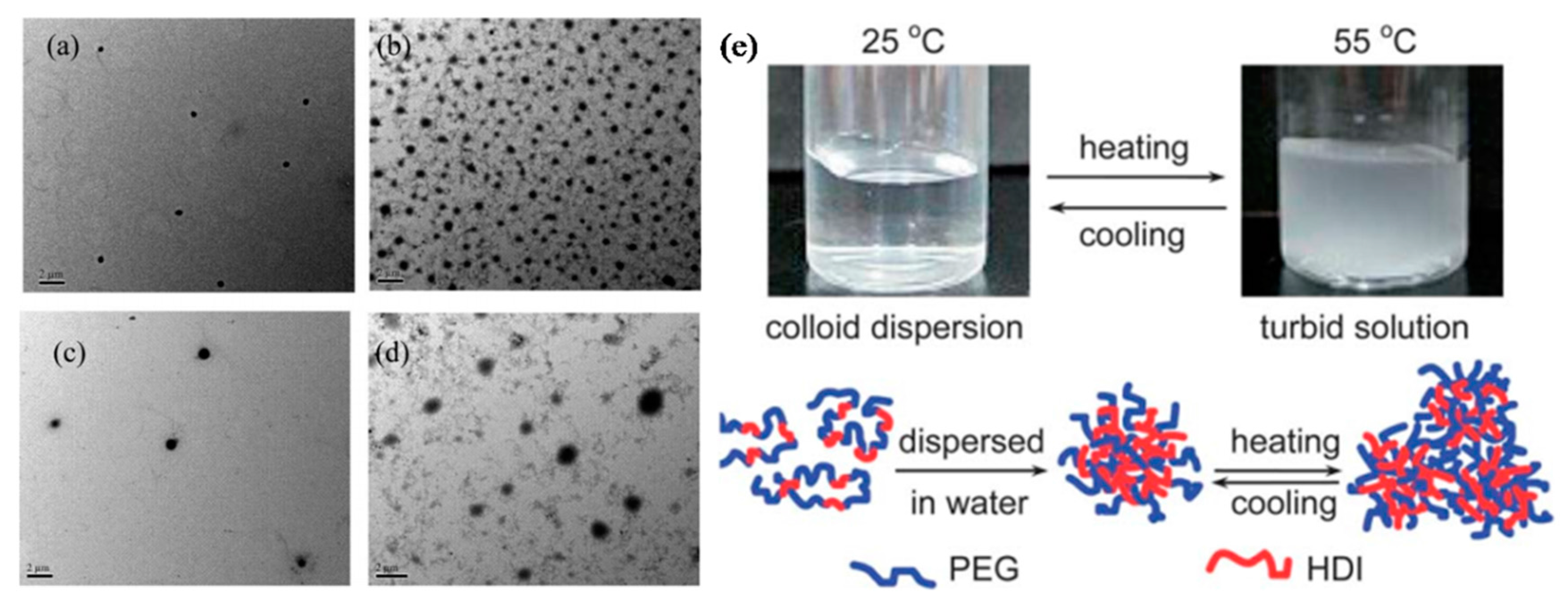
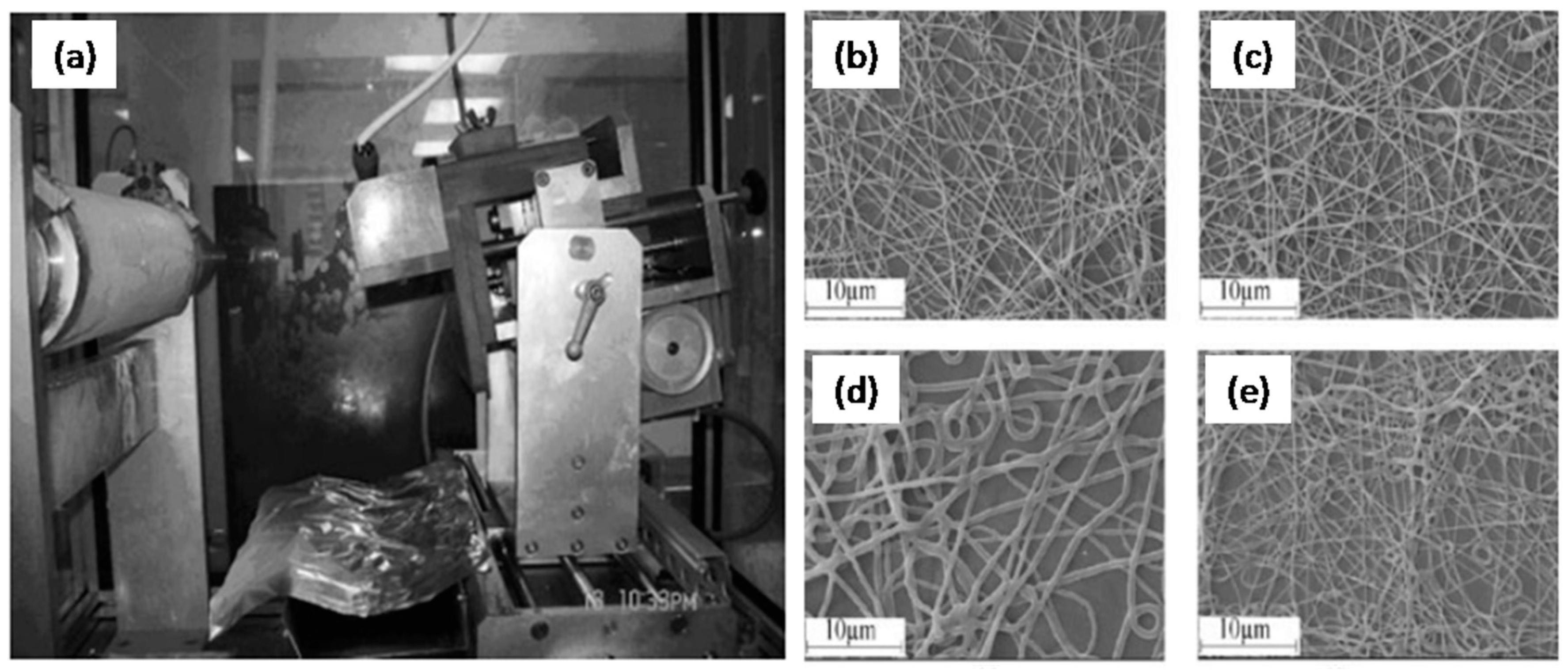





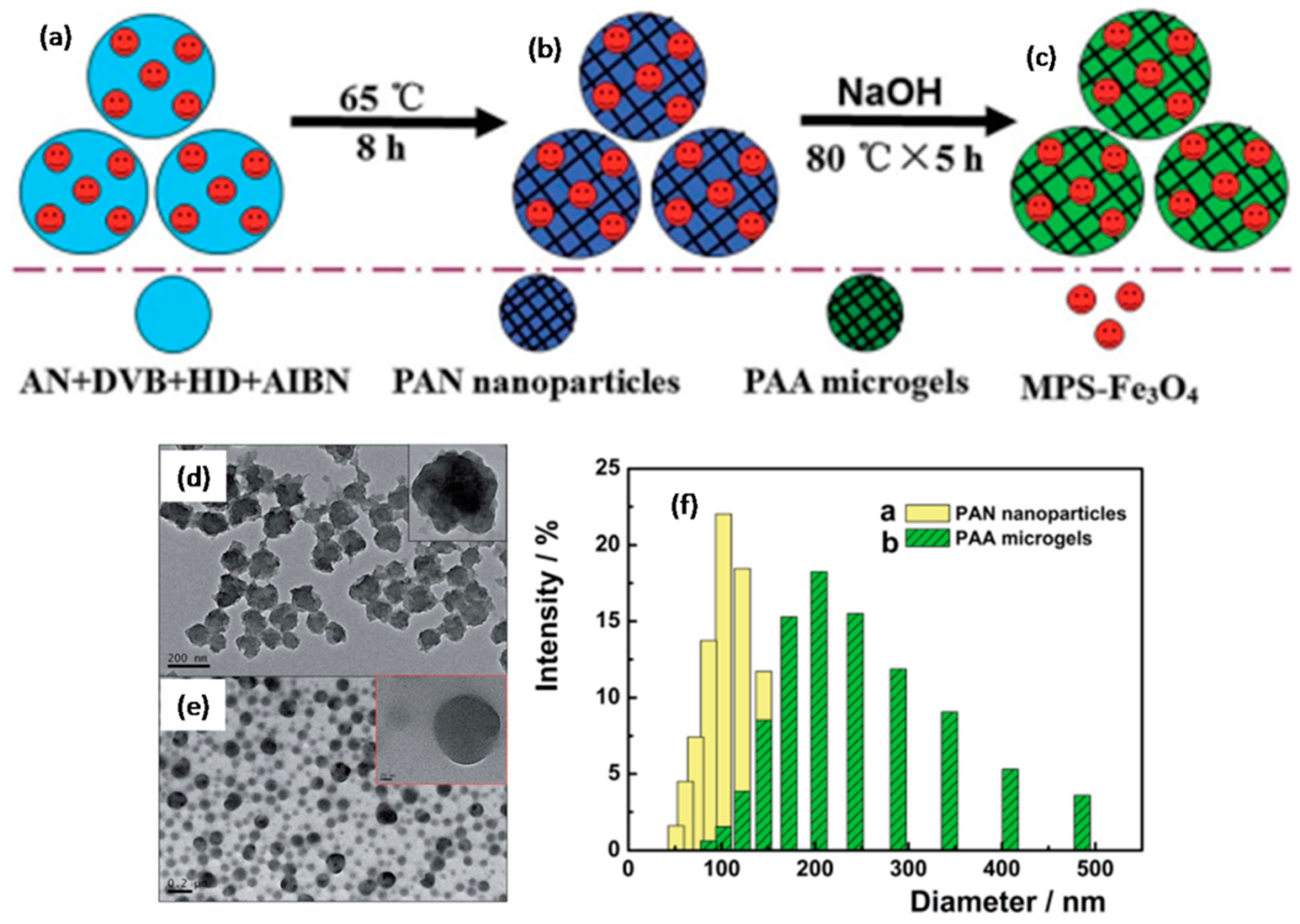
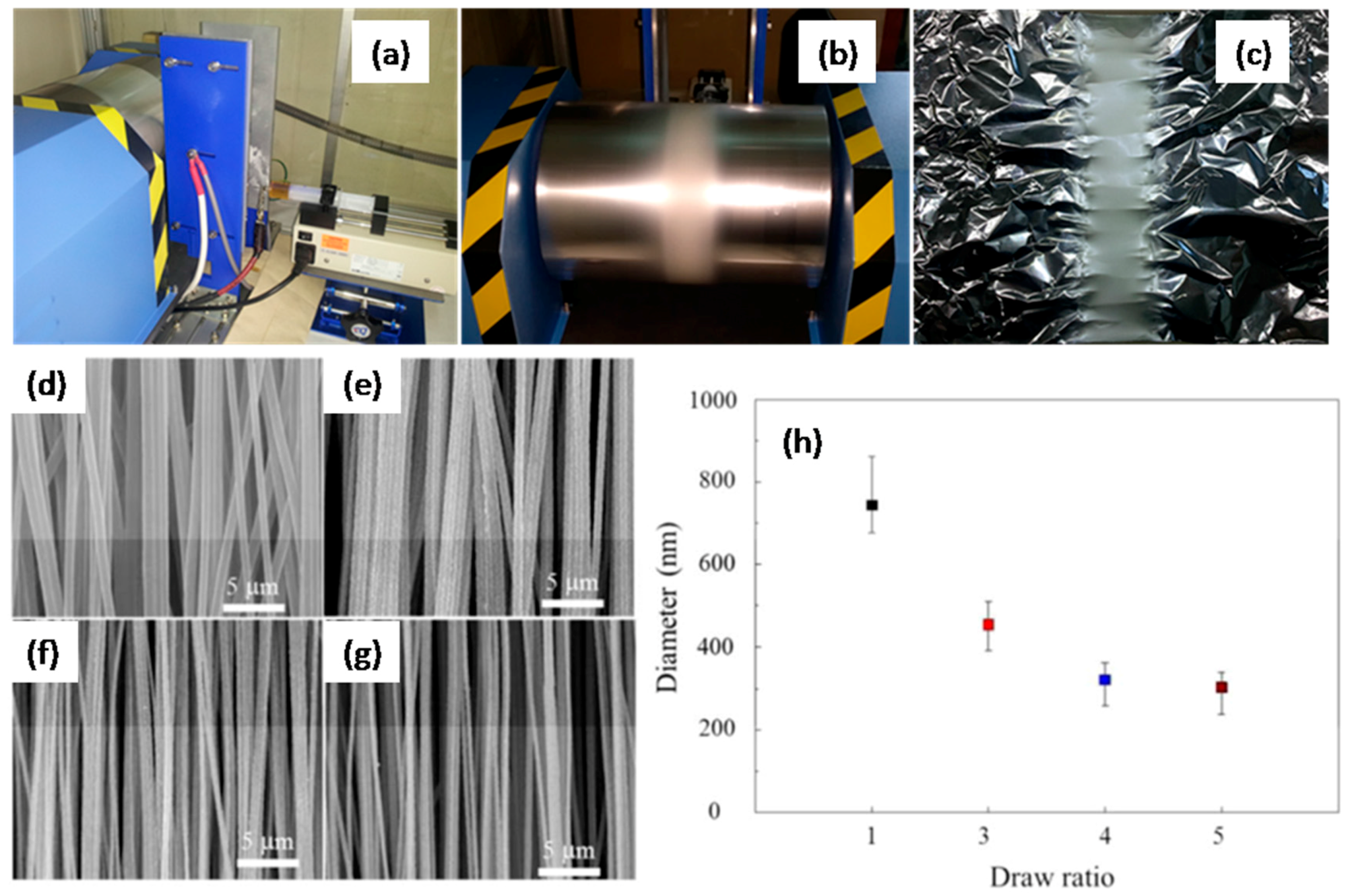

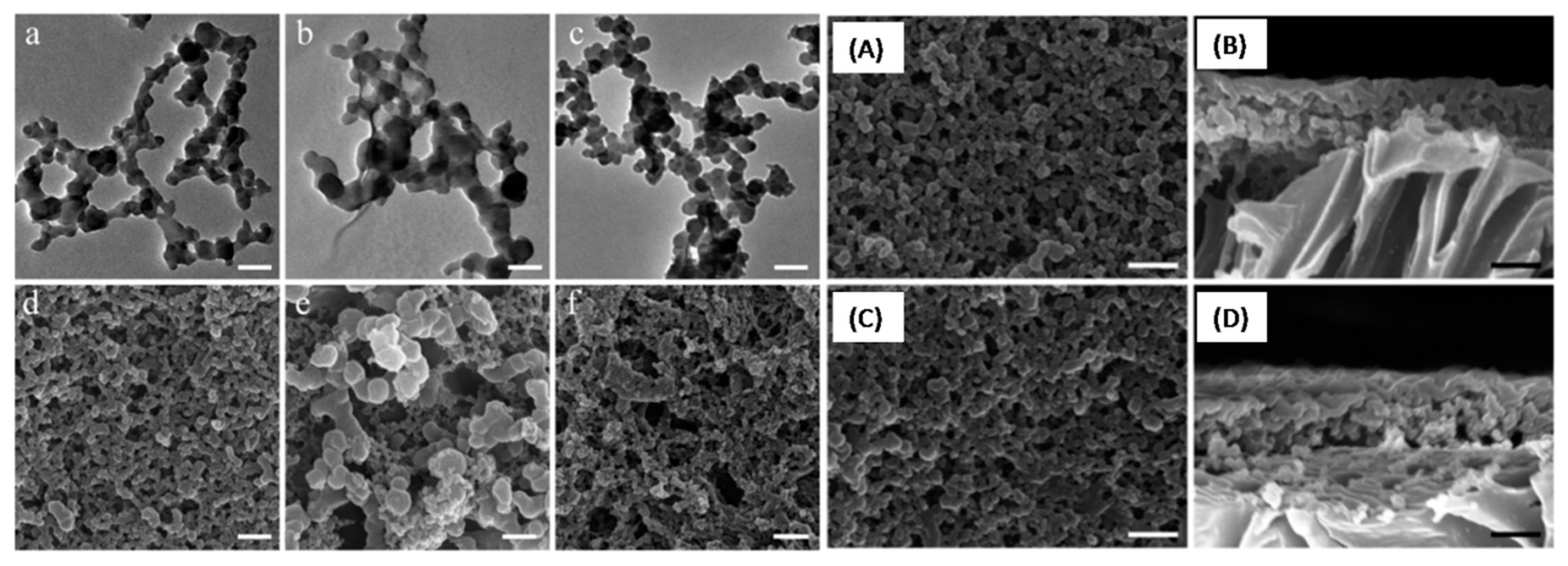
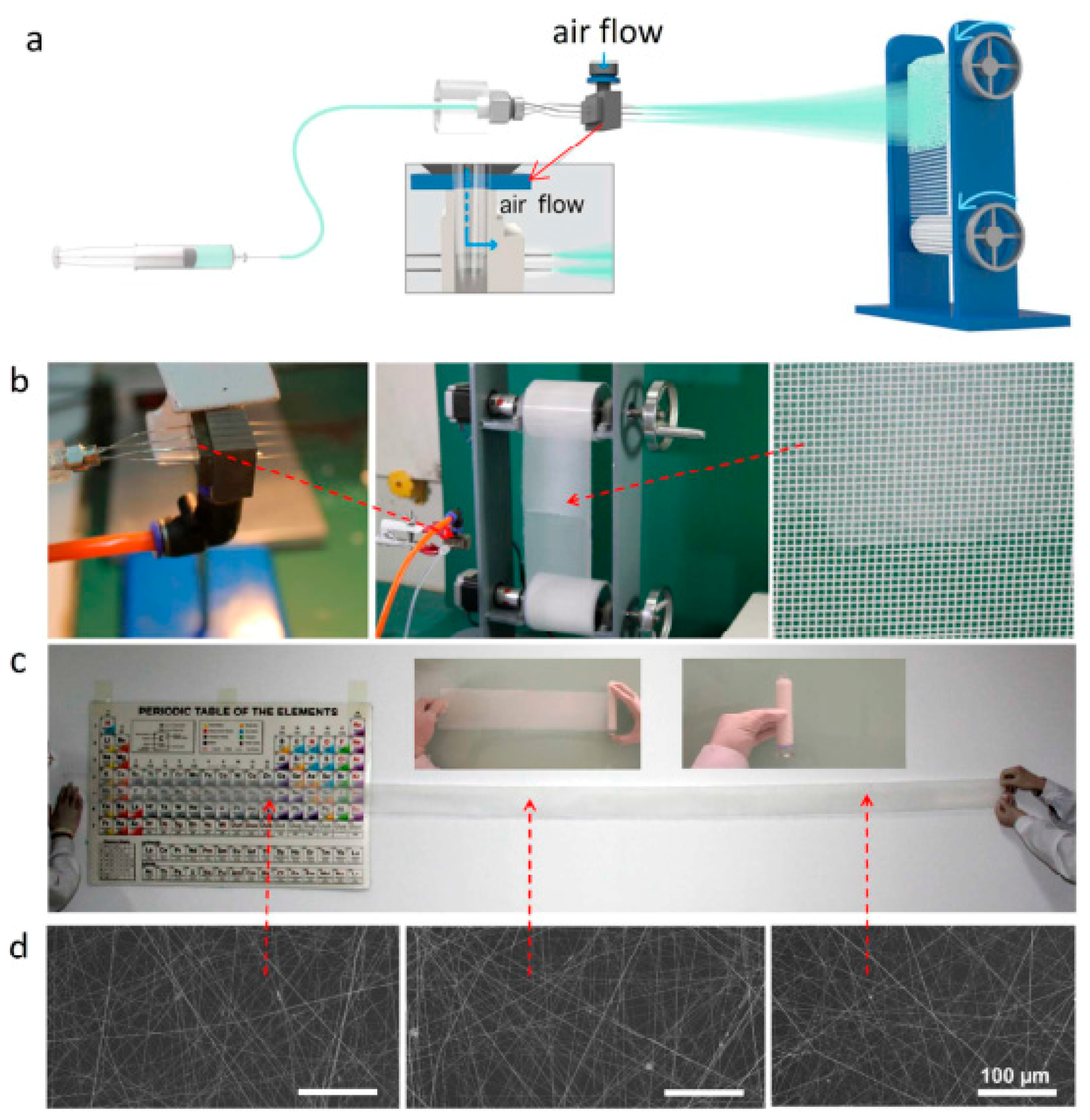
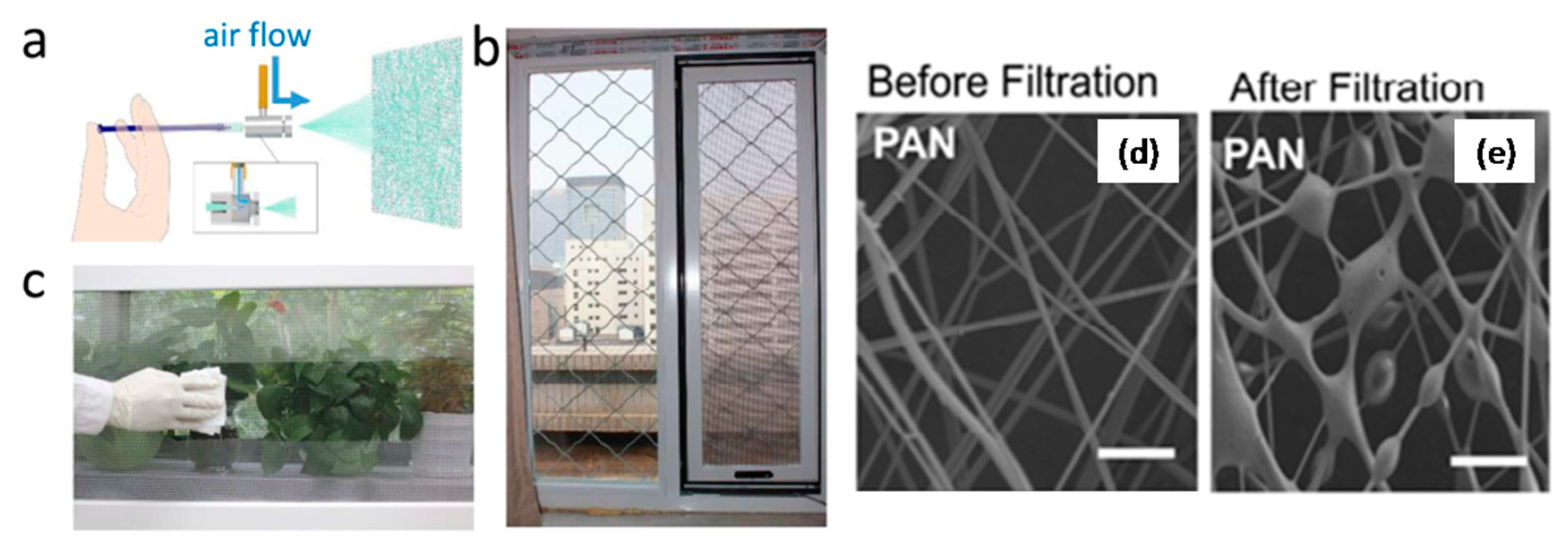
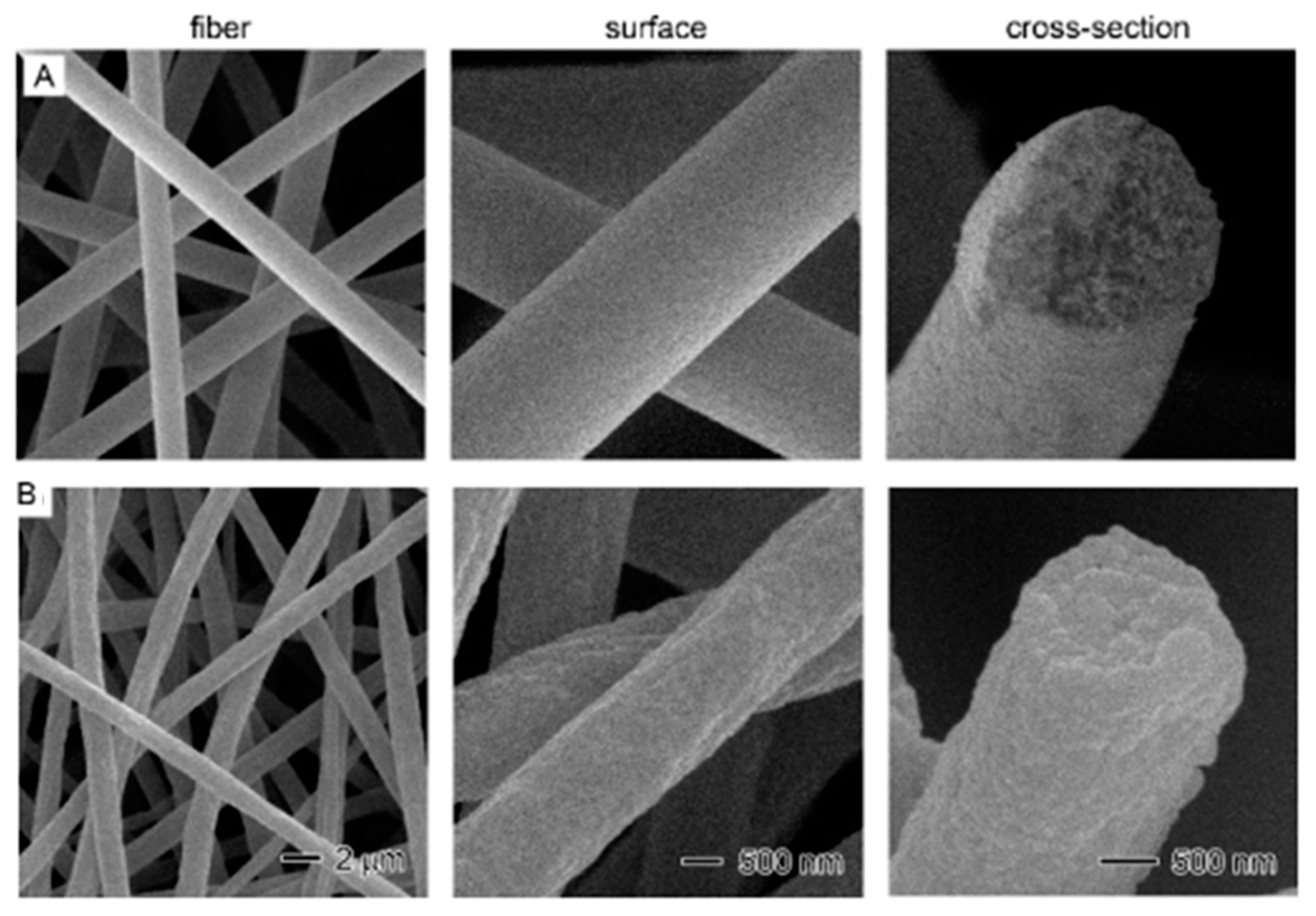
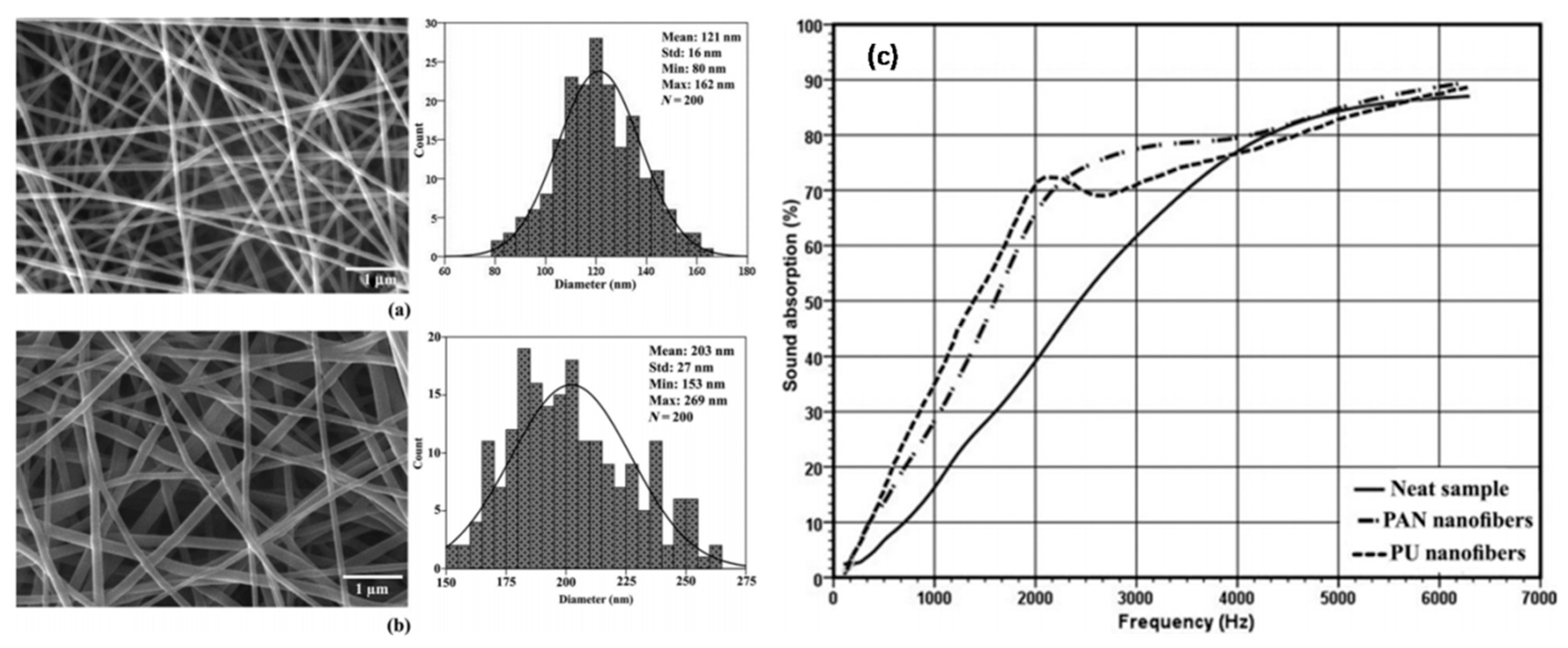
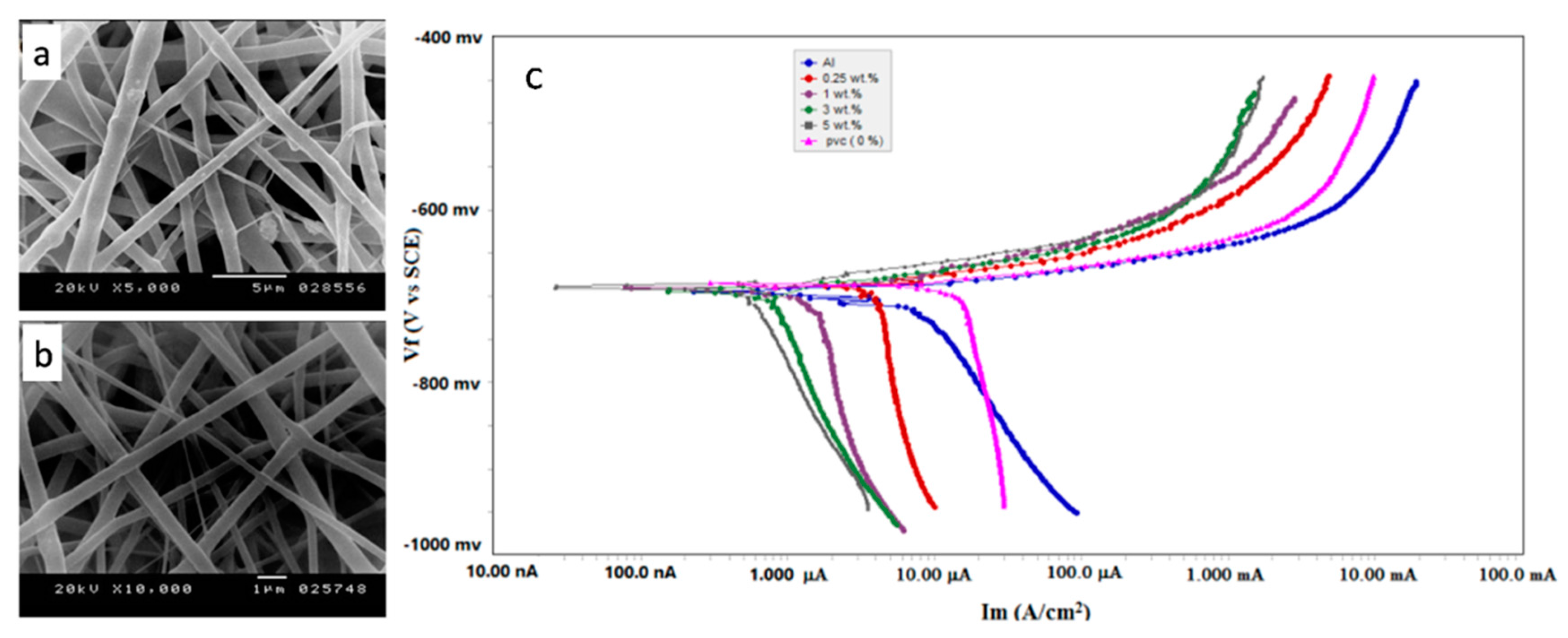
| Polymer | Applications in Buildings |
|---|---|
| Polystyrene (PS) | Roof insulation and masonry wall insulation |
| Polyurethane (PU) | Wall and roof insulation, curtain wall panels, insulation of industrial pipes and storage tanks, sandwich panels. |
| Polyvinyl chloride (PVC) | Sandwich structured panel and foam layer in coated fabric flooring |
| Polyacrylonitrile (PAN) | Gas filtration membranes, outdoor awnings, fiber reinforced concrete |
| Low-density poly ethylene (LDPE) | Film (packaging, agricultural film), extrusion coating (wires and cables), utensils |
| High-density poly ethylene (HDPE) | Liquid storage (tanks, drums), containers, pipes and extruded profiles, hospital material |
| Polyester (PET) | Sandwich panel and polyester coated concrete |
| Polypropylene (PP) | Containers, electrical appliance frames, tubes and geo-membranes |
| Acrylonitrile butadiene styrene (ABS) | Tubing and conduits |
| Polyvinyl acetate (PVAc) | Thermoplastic adhesives |
| Polyvinylidene fluoride (PVDF) | Electrical wire insulation |
| Polyimide (PI) | Electrical wire insulation |
| Polyamide (PA) | High performance fibers |
| Polymers | Synthesis | Morphology | Size (nm) | Notes | Ref. |
|---|---|---|---|---|---|
| NS-PU | Condensation | Particle dispersion | 60–345 | Acetone (s), 60 °C (T), 4 h (t) | [44] |
| Nanoprecipitation; Sonication | Particle | 280–300 & 330–450 | Nanoprecipitation: Acetone (s), water (s), r.t. (T), 24 h (t) | [45] | |
| Sonication: water (s), r.t. (T), 2 min (t) | |||||
| Stirring in acid; Dialysis | Particle | 250–750 | Stirring in acid: HCl (s), r.t. (T) | [46] | |
| Dialysis: DMF (s), Water (s), r.t. (T) | |||||
| Miniemulsion | Particle | 200–300 | Water (s), 60 °C (T), 4 h (t) | [47] | |
| Emulsion | Particle | 80–130 | Water (s), 80 °C (T), 2 h (t) | [48] | |
| Electrospinning | Fiber | 50–700 | DMF (s), 3–12 wt % (c), 12–25 kV (V), 0.04–0.1 mm/min (f.r.), 15 cm (d) | [49] | |
| Electrospinning | Fiber | 418–464 | DMF (s), 7 wt % (c), 40 kV (V), 3 mL/h (f.r.), 15 cm and 25 cm (d) | [50] | |
| Electrospinning | Fiber | 80–250 | DMF (s), 75 kV (V), 21 cm (d) | [51] | |
| Electrospinning | Fiber | 250 | DMF (s), 13.5 wt % (c), 75 kV (V), 21 cm (d) | [52] | |
| Solution blowing | Fiber | 100–400 | DMF (s), 6–12 wt % (c), 0.15–0.3 MPa gas pressure, 50 °C (T) | [53] | |
| Solution blowing | Fiber | 170 ± 112 & 671 ± 136 | DMF (s), 10, 15, 20 wt % (c), 1–6 bar gas pressure, 15–50 cm (d) | [54] | |
| NS-PS | Emulsion | Particle | ~31 | Acetone/water (s), 60 °C (T), 2–14 h (t) | [55] |
| Emulsion | Particle | 52–92 | Water (s), 90–95 °C (T), 7–20 min (t) | [56] | |
| Electrospinning | Fiber | 150–800 | DMF/THF (s), 20 wt % (c), 20 kV (V), 1 mL/h (f.r.), 15 cm (d) | [57] | |
| Electrospinning | Fiber | 380–500 | DMF/THF (s), 15 wt % (c), 20 kV (V), 0.1 mL/h (f.r.), 15 cm (d) | [58] | |
| Electrospinning | Fiber | 250–1000 | DMF (s), 15 wt % (c), 20 kV (V), 0.8 mL/h (f.r.) | [59] | |
| Electrospinning | Fiber | 317 | DMF (s), 20 wt % (c), 20 kV (V), 0.18 mL/h (f.r.) | [60] | |
| Fast freeze | Fiber | 19 | DCE (s) or CH (s), 0.01 wt %, frozen in liq. N2, −50 °C (T) | [61] | |
| NS-PAN | Miniemulsion polymerization | Particle | 100–180 | Water (s), 55 °C (T), 4 h (t) | [62] |
| Dispersion polymerization | Particle | 143.5–263.5 | Water (s), 30 °C (T), 24 h (t) | [63] | |
| Emulsion polymerization | Particle | <100 | Water (s), 67 °C (T), 5 h (t) | [64] | |
| Microemulsion polymerization | Particle | 40–50 | Water (s), r.t. (T), 10 min (t) | [65] | |
| Miniemulsion polymerization | Particle | 105–230 | Water (s), 65°C (T), 8 h (t) | [66] | |
| Electrospinning | Fiber | 302–744 | DMSO (s), 12 wt % (c), 17–23 kV (V), 1 mL/h (f.r.) | [67] | |
| Electrospinning | Fiber | 575 | DMF (s), 12 wt % (c), 18 kV (V), 1 mL/h (f.r.) | [68] | |
| Electrospinning | Fiber | 50–100 | DMF (s), 6.25 wt % (c), 20 kV (V), 1.25 mL/h (f.r.), 15 cm (d) | [69] | |
| Electrospinning | Fiber | 230–330 | DMF (s), 10 wt % (c), 17 kV (V), 1.2 mL/h (f.r.), 16 cm (d) | [70] | |
| Electrospinning | Fiber | 225–335 | DMF (s), 9 wt % (c), 15 kV (V), 1.2 mL/h (f.r.), 15 cm (d) | [71] | |
| Electrospinning | Fiber | 450–550 | DMSO (s), 8 wt % (c), 13–14 kV (V), 1.4 mL/h (f.r.), 15 cm (d) | [72] | |
| Electrospinning | Fiber | 294 | DMF (s), 8 wt % (c), 27 kV (V), 4 mL/h (f.r.), 13 cm (d) | [73] | |
| Microemulsion | Fiber | 20–50 | Water (s), r.t. (T), 4.5 h (t) | [74] | |
| NS-PVC | Modification | Particle | 108–215 | H2SO4 (s), r.t. (T), 5 h (t) | [75] |
| Electrospinning | Fiber | 100 | DMF/THF (s), 10 and 15 wt % (c), 12–15 kV (V), 0.5 mL/h (f.r.), 12–18 cm (d) | [76] | |
| Electrospinning | Fiber | 100–180 | DMF/THF (s), 14–20 wt % (c), 20–29 kV (V), 0.2 mL/h (f.r.), 15 cm (d) | [77] | |
| Electrospinning | Fiber | 600–800 | DMF/THF (s), 9 wt % (c), 12 kV (V), 1 mL/h (f.r.), 12 cm (d) | [78] | |
| Freeze-extraction | Fiber | 45 | DCE (s), DMAC (s) or NMP (s), 0.01 wt % (c), frozen in liq. N2, −50 °C (T) | [79] |
| Polymers | Building Application | Synthesis | Morph. | Size (nm) | Notes | Performance | Ref. |
|---|---|---|---|---|---|---|---|
| PAN | Air filtration | Blow spinning | Fiber | 150–250 | DMF (s), 10 wt % (c) | Minimum 90.6% removal efficiency of PM 2.5 over 12 h. | [81] |
| PAN | Air filtration | Electrospinning | Fiber | 200 | DMF (s), 6 wt % (c), 18 kV (V), 4 mL/h (f.r.), 20 cm (d) | Significantly improved PM 2.5 capture capability | [82] |
| PI | Air filtration | Electrospinning | Fiber | 300 | DMF (s), 15 wt % (c) | High temperature PM 2.5 removal with high efficiency (>99.5%) | [83] |
| Nylon-6 | Air filtration | Electrospinning | Fiber | 100 | Formic acid (s), 20% (c), 15 kV (V), 0.06 mL/h (f.r.), 15 cm (d) | >99.97% removal of PM 2.5 at ~73% of transmittance | [84] |
| PC | Air filtration | Electrospinning | Fiber | 319 ± 27 | Chloroform (s), THF/DMF (s), 14% and 16% (c), 18 kV (V), 0.06 mL/h (f.r.), 20 cm (d) | high filtration efficiency of 100% | [85] |
| PAN/PSU | Air filtration | Electrospinning | Fiber | 300–500 | DMF (s), 9 wt % for PAN(c), 22 wt % for PSU, 30 kV (V), 1 mL/h (f.r.), 20 cm (d) | high filtration efficiency of 99.992% | [86] |
| PVDF | Air filtration | Electrospinning | Fiber | 510 | DMF (s), 22 wt % (c), 30 kV (V), 0.5mL/h (f.r.), 15 cm (d) | high filtration efficiency of 99.972% | [87] |
| PAN | Air filtration | Electrospinning | Fiber | 900 | DMF (s), 12 wt % (c), 12 kV (V), 60mm/min (f.r.), 12 cm (d) | high filtration efficiency of 97% | [88] |
| PS | Thermal energy storage | Emulsion polymerizaiton | Particle | 10–115 × 103 | Water (s), 70 °C (T), 6 h (t) | Good for latent heat energy storage at low temperature | [89] |
| PS | Thermal energy storage | Microemulsion polymerizaiton | Particle | 100–123 | Water (s), 65 °C (T), 5 h (t) | Good for latent heat energy storage | [90] |
| PS | Thermal energy storage | Miniemulsion polymerizaiton | Particle | 250 | Water (s), 80 °C (T), 24 h (t) | Good for thermal energy storage | [91] |
| PS | Thermal energy storage | Electrospinning | Fiber | 1300–1930 | DMF (s), 20 wt % (c), 15 kV (V), 1 mL/h (f.r.), 25 cm (d) | 78.4% energy storage capacity | [92] |
| PSAN | Thermal energy storage | Electrospinning | Fiber | - | DMF (s), 20 wt % (c), 11–17 kV (V), 0.04 mm/s (f.r.), 20–35 cm (d) | Good ability to store thermal energy | [93] |
| PET | Thermal energy storage | Electrospinning | Fiber | 282–500 | DMF (s), 12 wt % (c), 16 kV (V), 2 mL/h (f.r.) | Good storage capacity of thermal energy | [94] |
| PEO | Thermal energy storage | Electrospinning | Fiber | 200 | Water (s), 5 wt % (c), 10–11 kV (V), 0.18 mL/h (f.r.), 10 cm (d) | Thermal energy storage capacity | [95] |
| PU & PAN | Sound absorption | Electrospinning | Fiber | 121 ± 16 & 203 ± 27 | For NS-PAN: DMF/THF (s), 10 wt % (c), 12 kV (V), for PU:NS-PAN: DMF/THF (s), 9 wt % (c), 16 kV (V), 0.25 mL/h (f.r.); 12 cm (d) | Sound absorption coefficient at low frequencies; NS-PAN preferred | [96] |
| PU & PAN | Sound absorption | Electrospinning | Fiber | - | For NS-PAN: DMF/THF (s), 10 wt % (c), 12 kV (V), for PU:NS-PAN: DMF/THF (s), 9 wt % (c), 16 kV (V), 0.25 mL/h (f.r.); 12 cm (d) | Enhancement of sound absorption coefficient at all ranges of frequencies | [97] |
| PAN | Sound absorption | Electrospinning | Fiber | 333 ± 58 | DMF (s), 8 wt % (c), 10 kV (V), 1.2 mL/h (f.r.), 13 cm (d) | Enhancement of sound absorption in low and medium frequency range | [98] |
| PVDF | Sound absorption | Electrospinning | Fiber | 138–156 | DMF (s), 18 wt % (c), 20 kV (V), 0.5 mL/h (f.r.), 20 cm (d) | Efficient for sound absorption | [99] |
| PVC | Corrosion Inhibition | Electrospinning | Fiber | 486 & 620 | THF (s), 12 wt % (c), 20 kV (V), 9 mL/h (f.r.), 15 cm (d) | Reduction of corrosion currents and corrosion rates; enhancement of polarizationresistances | [100] |
| PU | Metal Coating | Emulsion polymerization | Particle | 35–95 | Cyclohexane(s), 45 °C (T), 8 h (t) | 25% of the material used for same application | [101] |
| PAN | Reinforced Adhesive | Electrospinning | Fiber | 362 ± 87 | THF (s), 10 wt % (c), 16 kV (V), 1 mL/h (f.r.), 15 cm (d) | Enhancement for the mechanical property | [102] |
| PA66 | Flame Retardant | Electrospinning | Fiber | 225–425 | Formic acid (s), 15–20 wt % (c), 30 kV (V), 0.5 mL/h (f.r.), 8 cm (d) | Mechanical properties and flame-retardancy improved | [103] |
© 2017 by the authors. Licensee MDPI, Basel, Switzerland. This article is an open access article distributed under the terms and conditions of the Creative Commons Attribution (CC BY) license (http://creativecommons.org/licenses/by/4.0/).
Share and Cite
Lu, Y.; Shah, K.W.; Xu, J. Synthesis, Morphologies and Building Applications of Nanostructured Polymers. Polymers 2017, 9, 506. https://doi.org/10.3390/polym9100506
Lu Y, Shah KW, Xu J. Synthesis, Morphologies and Building Applications of Nanostructured Polymers. Polymers. 2017; 9(10):506. https://doi.org/10.3390/polym9100506
Chicago/Turabian StyleLu, Yong, Kwok Wei Shah, and Jianwei Xu. 2017. "Synthesis, Morphologies and Building Applications of Nanostructured Polymers" Polymers 9, no. 10: 506. https://doi.org/10.3390/polym9100506





